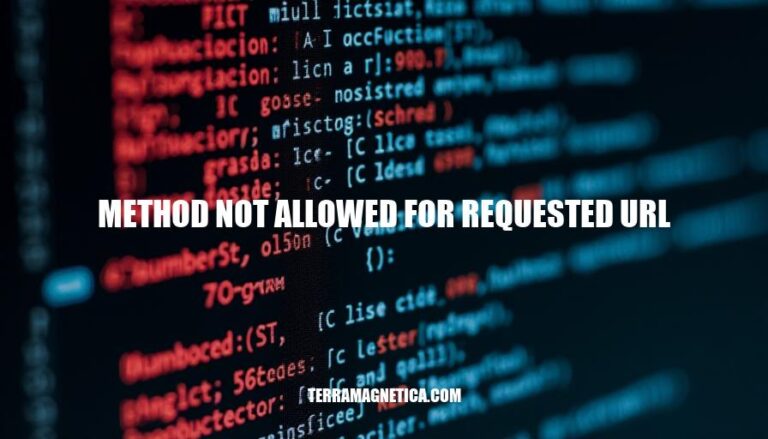The “Method Not Allowed for Requested URL” error, also known as HTTP 405, occurs when a web server recognizes the request method (like GET or POST) but rejects it for the requested resource. This error is significant in web development as it highlights issues with server configuration or client requests. Common scenarios include using the wrong HTTP method for an API endpoint or attempting to modify a resource with a method that only supports retrieval.
Understanding the Error
The “Method Not Allowed for Requested URL” error corresponds to the HTTP status code 405. This error occurs when the server recognizes the HTTP method (like GET, POST, PUT, DELETE) used in the request, but the method is not allowed for the specific URL.
Typical causes include:
- Incorrect HTTP method: Using a method not supported by the URL (e.g., using POST instead of GET).
- Server configuration: The server is set up to disallow certain methods for security or other reasons.
- Typos in the URL: Incorrect URLs can lead to this error if the server doesn’t recognize the resource.
- Outdated browser cache: Cached versions of the resource might have different allowed methods.
Common Causes
Here are the common reasons behind the “Method Not Allowed for Requested URL” error:
-
Incorrect HTTP Methods:
- Using the wrong HTTP method for the intended action, such as sending a GET request to a URL that only accepts POST requests.
-
Server Configuration Issues:
- The server might be configured to deny specific methods for security reasons or due to improper setup.
-
Security Restrictions:
- Web Application Firewalls (WAFs) or other security measures might block certain HTTP methods to prevent unauthorized actions.
-
API Restrictions:
- APIs may only support specific methods, and using an unsupported method can trigger this error.
-
Outdated Browser Cache:
- An outdated cache might hold an old version of the resource with different allowed methods.
-
Misspelled URL:
- Typos or incorrect URLs can lead the server to a non-existent resource, resulting in a 405 error.
Troubleshooting Steps
Here are the steps to troubleshoot and resolve the ‘Method Not Allowed for Requested URL’ error:
-
Check Server Configurations:
- Ensure the server is configured to accept the HTTP method being used (e.g., GET, POST, PUT, DELETE).
- Review server configuration files (e.g.,
.htaccess for Apache, nginx.conf for Nginx) for method restrictions.
-
Verify HTTP Methods:
- Confirm the correct HTTP method is being used for the intended action.
- Check for typos or incorrect methods in the client-side code or API requests.
-
Review Security Settings:
- Ensure security settings or firewalls are not blocking specific HTTP methods.
- Check for any security plugins or modules that might restrict certain methods.
-
Inspect URL and Endpoints:
- Verify the URL is correct and points to the intended resource.
- Ensure the endpoint is configured to handle the requested method.
-
Check Browser Cache:
- Clear the browser cache to ensure it’s not holding onto outdated configurations.
-
Review Server Logs:
- Examine server logs for detailed error messages or clues about the misconfiguration.
-
Debug Application Code:
- Look through the application code for any issues with how HTTP methods are being handled or routed.
These steps should help you identify and resolve the ‘Method Not Allowed’ error effectively.
Preventive Measures
To avoid encountering the ‘Method Not Allowed for Requested URL’ error, consider the following preventive measures:
-
Proper Server Configuration:
- Ensure your server is configured to accept the correct HTTP methods for each endpoint. For example, configure login endpoints to accept POST requests and data retrieval endpoints to accept GET requests.
- Regularly review and update server configurations to match application requirements.
-
Thorough Testing:
- Conduct comprehensive testing to ensure all endpoints respond correctly to the intended HTTP methods. This includes unit tests, integration tests, and end-to-end tests.
- Use automated testing tools to simulate various HTTP methods and verify server responses.
-
Regular Updates:
- Keep your server software and frameworks up to date to benefit from the latest security patches and features.
- Periodically audit your server settings and application code to ensure they align with current best practices.
-
Documentation:
- Clearly document the allowed methods for each endpoint in your API or web service documentation. This helps developers understand the correct usage and reduces the likelihood of errors.
-
Security Measures:
- Implement proper authentication and authorization to restrict access to sensitive operations. Use measures like CSRF tokens or request signing to prevent unauthorized requests.
By following these steps, you can significantly reduce the chances of encountering the ‘Method Not Allowed for Requested URL’ error.
The ‘Method Not Allowed for Requested URL’ Error
The ‘Method Not Allowed for Requested URL’ error occurs when a web server recognizes the request method but rejects it for the requested resource, typically due to incorrect HTTP methods, server configuration issues, security restrictions, API limitations, outdated browser cache, or typos in the URL.
To troubleshoot and resolve this error, check server configurations, verify HTTP methods, review security settings, inspect URLs and endpoints, clear browser cache, examine server logs, and debug application code.
Preventive Measures
Preventive measures include proper server configuration, thorough testing, regular updates, documentation, and security measures such as authentication and authorization to restrict access to sensitive operations.


